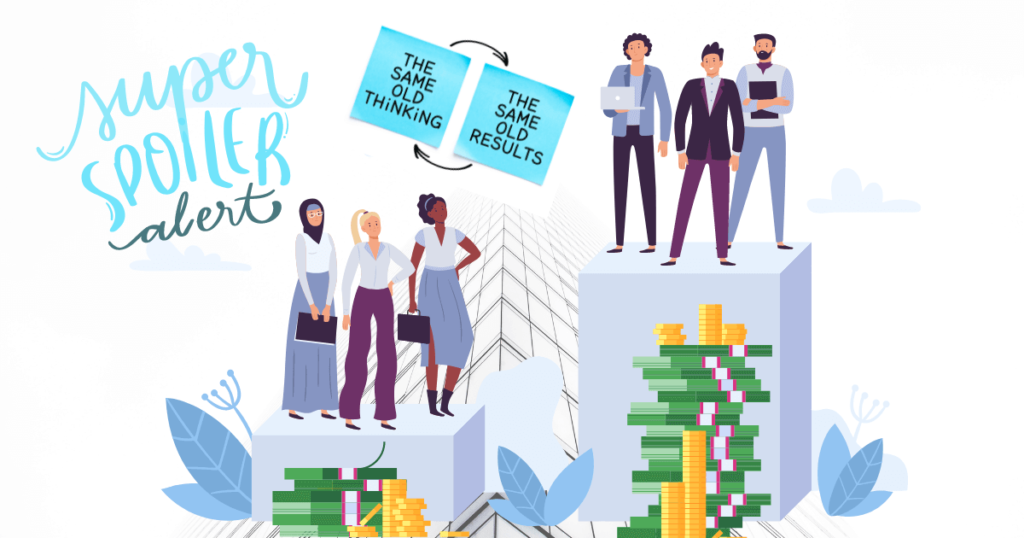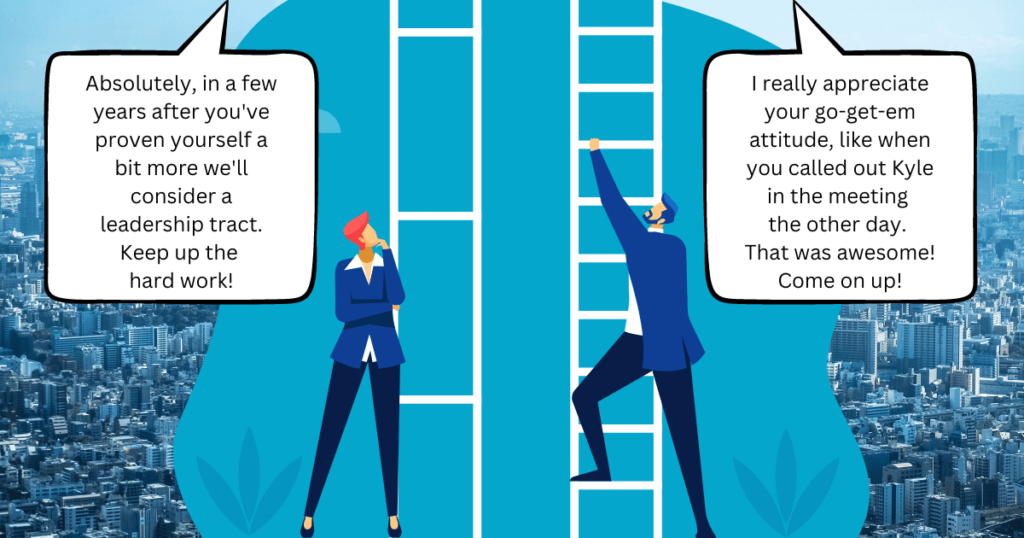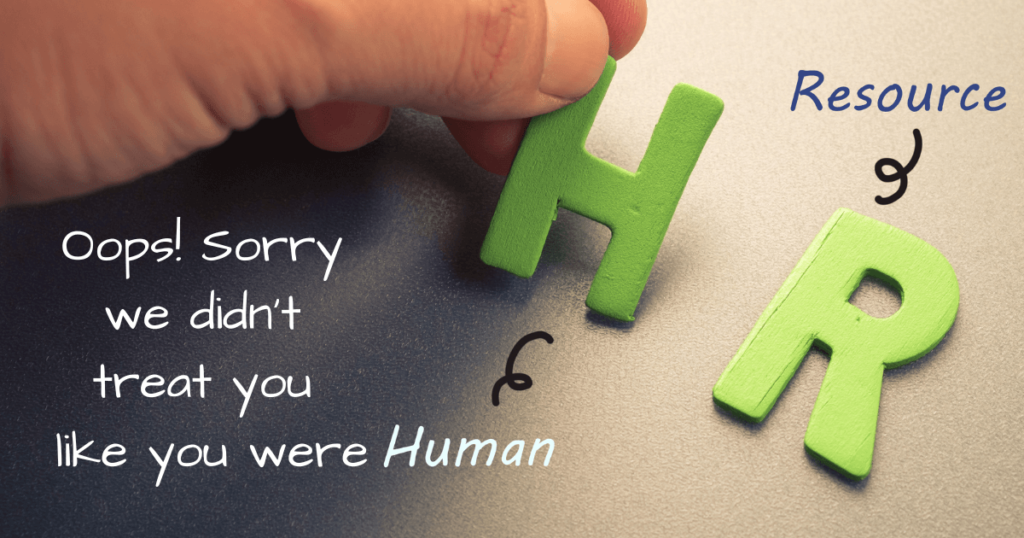The Socioeconomics of Being a Woman in Business – Spoiler Alert: It’s still the same.


Same Ol’, Same Ol’
The challenges of being a woman in business are numerous and well-documented.
Even in the graphic above, the white woman should be the only one standing on the platform if this were gonna be accurate…. but for now – women.
Women continue to face an uphill battle for equal representation at all levels of capitalism, as well as a double standard when it comes to how they are perceived and treated based on their gender alone.
For example, women entrepreneurs receive only about one-fifth as much venture capital funding as male peers.
A recent report also found that men received more than twice as many job offers after negotiating the same initial offer with prospective employers.
There’s even evidence that men are offered higher salaries than women when they interview for the same position with the same company – based solely on whether or not their name is listed first on their resume!
These issues extend beyond just individual experience and into something more systemic.
Women have less access to mentors, have smaller networks, and often lack abundant and essential institutions like trusts or foundations to support women in business.
Women are seen as a support system to men. In the workplace, you’re either someone they hope they can fuck, someone they can co-misogyny with, or someone they see as the matriarch/caretaker/support.
To me, this is most obvious in these numbers: 94.1% of Executive Assistants to CEOs are women. 15% of CEOs at the highest-performing companies in the U.S. are women.
~ Me. I said this with stats from Google.
This is counter-productive for society as a whole.
The truth is that businesses led by women perform better, reinvest more profits into their communities, and create more jobs than men.
What’s the Real Cost of Being a Woman in Business?

Research shows that American companies could increase their profits by upwards of $1.3 trillion if women could achieve equal representation in business.
That’s an enormous figure, but it doesn’t even begin to quantify the loss of human potential and societal value that results from the under-representation of women in business.
So what’s missing when women are excluded from entrepreneurship, ownership, and essential leadership roles?
There are many areas where research indicates gender diversity has a positive impact on business outcomes.
Higher ROI, More Sustainable Growth, and Improved Profitability
When women are better represented in ownership and executive roles, companies have higher returns on investment, more sustainable growth, and improved profitability.
Open Sign Stays ON
Women-led companies also have a greater chance of survival. According to research, businesses led by women are far less likely to fail than those led by men – even when accounting for general industry factors and risk factors that may affect both types of businesses.
When Women Earn Everybody Wins
Women-owned businesses are also more likely to reinvest retained earnings back into their companies and employees. They also reinvested into the community through education, community resources, and emergency services.
The Socioeconomic Divide Between Men & Women
Systemic Racism. Sexism. Agism. Biases. Gender Pay Gap. Patriarchy. Work Hours Based on Masculine Hormone Cycles. Class. Favoritism. Nepotism. Funding Disparities. The lack of any feminine place or language in capitalism – other than to be in service to others, even if to your detriment.
The divide is now so great huge amounts of talent have been lost to women leaving the workforce entirely, entering the gig/hustle economy, creating passive income streams, or starting their businesses.
Great Exit

Some current buzzwords are Quiet Quitting, Great Resignation, Great Rethink, and the Great Reshuffle.
Having been in competitive corporate environments, all this means to me is:
After watching all of the systems that run us come crumbling down in just weeks of a global pandemic, employees are feeling their vulnerable mortality in a way they only experienced when a coworker left or died from addiction, cancer, or some other major health challenge such as disability.
They continue to be bombarded with daily trauma that they cannot heal from – as the trauma is still happening.
They are asked to mask and suppress portions of themselves for the higher priority of the company’s bottom line.
They watched as they lost family, friends, and coworkers to short-term and long-term disability and death.
The active value exchange of dollars to hours, if you weren’t in a benefit group mentioned above, just isn’t worth it anymore.
Traditional Institutions Won’t Voluntarily Make Room for Women
Women make up more than half of the American workforce, and their participation in the labor market has grown over the last few decades.
However, women are still under-represented in many high-paying and high-earning sectors. They may never equal that representation as long as toxic masculinity is the majority at the helm of decision-making.
In a traditional system, the gender pay gap is still a real problem – and a serious economic challenge for American families.
In addition to earning less than men, women are more likely to live in poverty than men.
Women are also more likely to be single parents and assumed to be the ones to take time off from the workforce in a crisis or to care for family members.
As a result, women tend to have fewer savings and much less money in retirement accounts and are, therefore, more financially vulnerable than men.
Great Reengagement

Company and HR Industry organizations call the Great Exit a good thing; their opportunity is now in the upcoming phase they call the Great Reengagement.
They feel that in a company’s Employee Experience (EX) planning, they need a (paraphrased) portal where employees can stay updated on company goals and objectives and where employees can even find social media bites they can use in their posts.
They even recommend Stay Interviews for employees you want to keep around to find out how they are enjoying their work and what improvements can be made to stay in their roles.
The known work environment will never be the same again. It will likely need to continue to go through a process of dismantling and rebuilding as the humans who keep it going continue to reevaluate their existence here and what is important to them.
Health and Socioeconomic Status
Work stress due to low pay, poor management, lack of empowerment, etc. has been identified as a risk factor for hypertension, diabetes, upper extremity musculoskeletal problems, back problems, and cardiovascular disease. Substance use frequency and severity, as well as infertility, are associated with job stress and burnout.
Regardless of the industry, the difference in workers’ health directly correlates with the additional psychological stressors that low income brings to a person’s brain and body.
These illnesses and chronic conditions affect more than just these individuals and their loved ones – it impacts our entire community and nation.
Bottom Line
In an ideal world, socioeconomic status and gender would not affect whether you can be hired, promoted, funded, start, or succeed in business.
We’re not there. We don’t yet live in a world where everyone is treated equally or has the same level of access to the resources they need to succeed.
If you’re a woman looking to start a business or expand an existing one, you must be aware of the challenges you may face in traditional spaces. Seek support through organizations that provide FREE consulting and resources to their communities.
Check out my Do Stuff And Get Stuff Done – A Guide For Women Entrepreneurs to help while you’re running your business.
Seek support through online communities of people doing the same thing as you.
You can also work to help bridge the gap between men and women by advocating for increased representation, support, and FUNDING for women entrepreneurs.
Read It Again
Now reread this article adding “Black” in front of all instances of “Woman” and changing the word “Gender” to “Race.”
I believe that’s where the focus needs to be for changing our economic systems to benefit everyone.
MORE ABOUT FREE CONSULTING AND FREE OR LOW-COST CLASSES
The Small Business Administration (SBA) funds these organizations when they meet defined goals. Usually, they provide free one-on-one consulting and free or low-cost classes to their community that helps you achieve milestones in your business.
That’s it!
If you do decide to seek consulting or mentors – here are three fear-reducing tips:
If you work with someone and it doesn’t feel right – get/ask for someone else. Ensure your consultant sets clear goals with you and helps you decide the steps and actions to achieve them.
Just because one or ten people tell you that your idea isn’t that good – AND you’ve used the tools available to you to tell you that it IS – those ten people simply may not be your customer.
Don’t give strangers false authority over what you know just because they are presented to you as the expert, consultant, or mentor. Take in the information and then determine if it is true/useful or needs to be discarded.
Mailing List
Like this? Want more? Enter your email address to join the mailing list.




